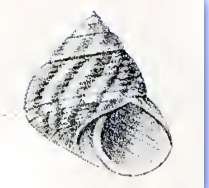Gibbula adansonii
Gibbula adansonii is a species of sea snail, a marine gastropod mollusk in the family Trochidae, the top snails.[2]
- Subspecies
- Gibbula adansonii adansonii (Payraudeau, 1826)
- Gibbula adansonii sulliottii Monterosato, 1888
| Gibbula adansonii | |
|---|---|
 | |
| Drawing of a shell of Gibbula adansonii | |
| Scientific classification | |
| Kingdom: | Animalia |
| Phylum: | Mollusca |
| Class: | Gastropoda |
| Clade: | Vetigastropoda |
| Order: | Trochida |
| Superfamily: | Trochoidea |
| Family: | Trochidae |
| Genus: | Gibbula |
| Species: | G. adansonii |
| Binomial name | |
| Gibbula adansonii (Payraudeau, 1826) [1] | |
| Synonyms | |
| |
Description
The height of the shell attains 12 mm, its diameter 10½ mm. The narrowly umbilicate shell has a conical shape. Its color is maroon or deep brown, with longitudinal undulating flames of white, continuous or interrupted into spots on the base. The elevated spire is conoidal and contains 6 to 7convex whorls, traversed by numerous spiral striae. The large body whorl is dilated and subangulate at the periphery. The base of the shell is convex, concentrically finely lirate, each ridge divided by a central impressed line. The sutures are deeply impressed. The aperture is subquadrangular. The columella is straight or a little projecting in the middle. The deep umbilicus is very narrow, bounded by a carina.[3]
Distribution
This species occurs in the Mediterranean Sea, the Adriatic Sea and the Black Sea.
References
- Payraudeau B. C., 1826: Catalogue descriptif et méthodique des Annelides et des Mollusques de l'île de Corse ; Paris pp. 218 + 8 pl
- Gibbula adansonii (Payraudeau, 1826). Retrieved through: World Register of Marine Species on 1 May 2010.
- Tryon (1889), Manual of Conchology XI, Academy of Natural Sciences, Philadelphia
- Gofas, S.; Le Renard, J.; Bouchet, P. (2001). Mollusca, in: Costello, M.J. et al. (Ed.) (2001). European register of marine species: a check-list of the marine species in Europe and a bibliography of guides to their identification. Collection Patrimoines Naturels, 50: pp. 180–213
External links
- "Gibbula adansonii". Gastropods.com. Retrieved 16 January 2019.
| Wikimedia Commons has media related to Gibbula adansonii. |